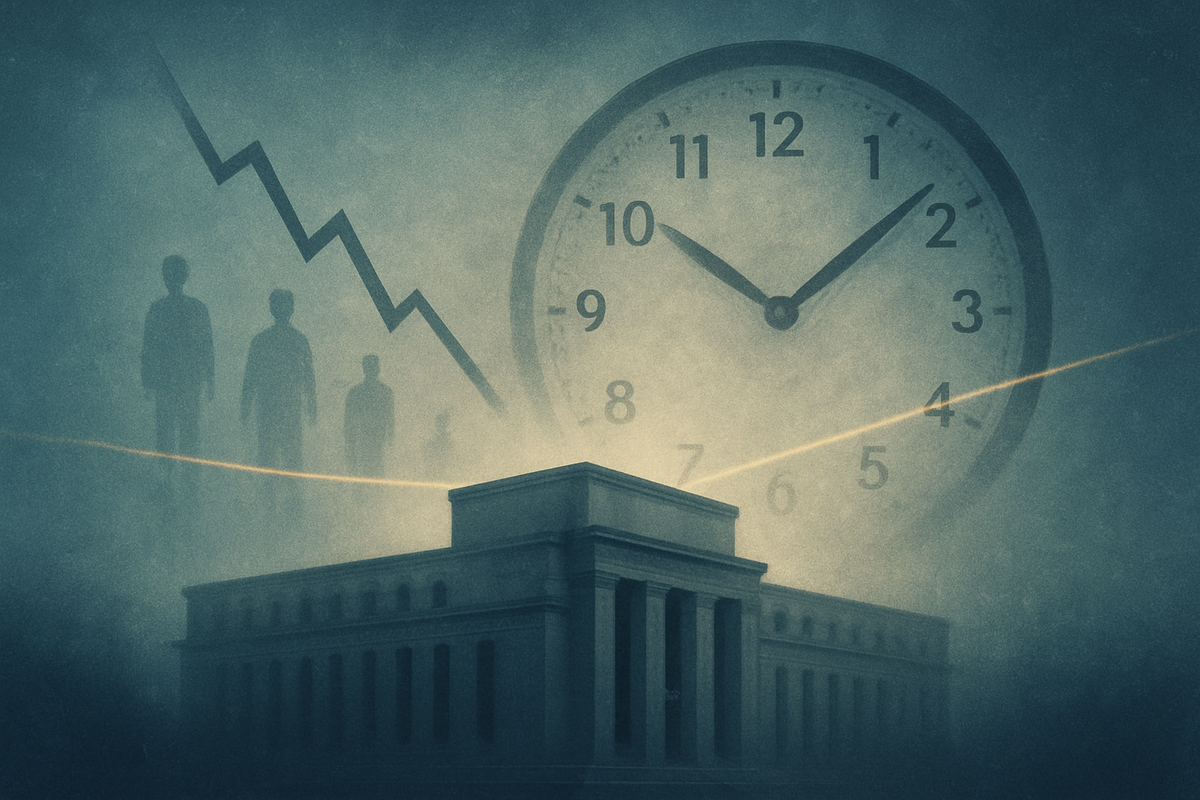Federal Reserve's Barkin Signals Softening Labor Market, Stays Mum on December Rate Cut, Fueling Market Speculation

Richmond Fed President Thomas Barkin's recent remarks have sent ripples through financial markets, as he painted a picture of a softening labor market while pointedly avoiding any guidance on the Federal Reserve's upcoming December Federal Open Market Committee (FOMC) meeting. Delivered on Tuesday, November 18, 2025, these statements have intensified speculation regarding the trajectory of interest rates, with many now perceiving an increased likelihood of a rate cut by year-end, even amidst official non-committal stances.
Barkin's comments, which highlighted a "low-hire, low-fire" environment and a labor market that feels "quite available," suggest a growing concern within the central bank about the employment side of its dual mandate. This cautious assessment, coupled with his deliberate silence on the December meeting, underscores the profound uncertainty facing policymakers as they navigate persistent inflation and emerging signs of economic deceleration. The market's immediate reaction has been a mixed signal, with some indicators pointing to a heightened probability of a rate cut, while others show a degree of skepticism, reflecting the complex interplay of economic data and central bank communication.
Unpacking Barkin's Cautious Stance and Market Disconnect
On Tuesday, November 18, 2025, at the Top of Virginia Economic Summit, Thomas Barkin, President of the Federal Reserve Bank of Richmond, articulated a nuanced view of the current economic landscape. He acknowledged the inherent tension in the Fed's dual mandate, noting "pressure on both sides of our mandate, with inflation above our target and job growth down." While headline unemployment remained low, Barkin's conversations with businesses in his district revealed a "somewhat weaker labor market than these numbers suggest," characterized by "low-hire, low-fire" dynamics and an abundance of "quality applicants per opening." He specifically cited recent layoff announcements from major corporations such as Amazon (NASDAQ: AMZN), Verizon (NYSE: VZ), and Target (NYSE: TGT) as "cause for caution," signaling a potential cooling in the labor market, though he didn't foresee a drastic deterioration.
Crucially, Barkin firmly declined to offer any forward guidance on the highly anticipated December 9-10 FOMC meeting. "Nothing I just said gives any guidance for our next meeting," he stated, emphasizing the need to "learn a lot between now and then." He likened the current economic situation to "docking a boat at night without a lighthouse," a vivid metaphor for the prevailing uncertainty, exacerbated by a recent federal shutdown impacting data availability. This non-committal stance aligns with Chairman Jerome Powell's cautious approach, reinforcing that a December interest rate cut is "not a matter that has already been decided."
The market's immediate response was complex. Following Barkin's remarks and other weak jobs reports, some analyses indicated an increased probability of a 25 basis point rate cut in December, with odds reportedly rising above 50%. This suggests that Barkin's acknowledgment of softening job growth was interpreted by many as strengthening the case for monetary easing. However, a notable "disconnect between Fed commentary and market pricing" was observed, with the CME FedWatch tool showing a 43% chance of a December rate cut, a decrease from 62% just a week prior. This divergence highlights the ongoing struggle for investors to reconcile official Fed rhetoric with evolving economic data and their own expectations, creating a volatile environment for financial assets.
Corporate Fortunes in a Shifting Rate Landscape
The implications of a potential Federal Reserve rate cut, spurred by a softening labor market, are far-reaching for public companies across various sectors. Generally, lower interest rates tend to stimulate economic activity, making borrowing cheaper for businesses and consumers, which can boost investment and spending. However, the context of why rates might be cut—a weakening job market—introduces complexities.
Companies in growth sectors and those with high debt loads often stand to gain the most from rate cuts. Technology firms, particularly those reliant on venture capital or significant capital expenditures, could see improved access to financing and lower debt servicing costs. Companies like Amazon (NASDAQ: AMZN), despite recent layoffs, could find their growth initiatives more financially viable in a lower-rate environment, potentially benefiting their cloud computing (AWS) and e-commerce expansion plans. Similarly, housing and real estate-related companies could experience a resurgence as lower mortgage rates make homeownership more affordable, boosting demand.
Conversely, financial institutions, particularly banks, might face pressure on their net interest margins if lending rates fall faster than deposit rates. While a stronger economy could offset some of this, a rate cut driven by recessionary fears could harm their loan portfolios. Utility companies and other firms with stable, predictable cash flows that are often favored by income-seeking investors, might see their appeal diminished if bond yields fall, as investors might seek higher returns elsewhere. Companies like Verizon (NYSE: VZ), which operates in a relatively mature, capital-intensive industry, might see some relief on borrowing costs but could also face slower consumer spending if the broader economic slowdown deepens. Target (NYSE: TGT), a major retailer, could benefit from increased consumer spending power if lower rates stimulate the economy, but a persistent softening of the labor market could equally dampen consumer confidence and discretionary spending, posing a significant headwind. Ultimately, while rate cuts typically provide a tailwind, the underlying economic conditions driving those cuts will dictate the true winners and losers.
Broader Economic Currents and Policy Crossroads
Barkin's recent comments on employment and his cautious stance on future rate decisions are not isolated incidents but rather fit squarely into the broader economic narrative of 2025. The Federal Reserve continues to grapple with the challenge of bringing inflation down to its 2% target while avoiding a severe recession and maintaining maximum employment. Barkin's observations of a "low-hire, low-fire" environment and increased labor availability highlight the delicate balancing act required. This softening in the labor market, even if not yet reflected in headline unemployment figures, could be a critical factor in the Fed's decision-making, potentially shifting their focus more towards supporting employment.
The ripple effects of such a policy pivot could be substantial. For competitors and partners, a change in interest rate trajectory impacts everything from investment decisions to consumer demand. Sectors sensitive to consumer spending, such as retail and automotive, could see renewed activity if rates fall and confidence improves, or further contraction if the labor market weakens significantly. Internationally, a potentially more dovish Fed could influence global capital flows and currency valuations, affecting trade balances and the competitiveness of U.S. exports. Regulatory and policy implications are also significant; a weakening economy might prompt calls for fiscal stimulus from the government, potentially working in concert or at odds with monetary policy. Historically, periods of economic uncertainty and a softening labor market have often preceded shifts in Fed policy, underscoring the weight of Barkin's current assessment. The current situation echoes past instances where the Fed had to choose between fighting inflation and supporting a faltering job market, a decision that has always carried profound consequences.
Navigating the Path Ahead: Scenarios and Strategic Pivots
Looking ahead, the immediate focus will undoubtedly be on the December FOMC meeting. Short-term possibilities include a 25-basis point rate cut, a pause with a strong dovish leaning, or even a hawkish hold if incoming data surprisingly strengthens. A rate cut, while potentially stimulating, could also be interpreted by some as an admission of significant economic weakness, impacting market confidence. The long-term trajectory hinges on how the labor market evolves and whether inflation continues its descent. If employment continues to soften, the Fed might be compelled to implement a series of cuts, potentially leading to a more accommodative monetary policy through early 2026.
For businesses, strategic pivots may be necessary. Companies that have thrived in a higher-rate environment by focusing on efficiency and cost control might need to re-evaluate growth strategies. Those with significant capital expenditure plans might find a more favorable borrowing landscape. Market opportunities could emerge in sectors that benefit from lower borrowing costs and increased consumer liquidity, such as housing, automotive, and discretionary retail. Conversely, challenges could arise for sectors sensitive to economic downturns, even with lower rates, if the underlying demand remains weak. Potential scenarios range from a "soft landing" where the Fed successfully engineers a slowdown without a deep recession, to a more pronounced downturn if the labor market deteriorates rapidly, forcing more aggressive easing. Investors will be closely watching for further economic data, particularly employment reports and inflation figures, to gauge the Fed's next moves and adapt their portfolios accordingly.
The Fed's Tightrope Walk: A Summary of Key Takeaways
Federal Reserve official Thomas Barkin's recent commentary has underscored the central bank's precarious balancing act between taming inflation and preserving employment. His candid assessment of a "low-hire, low-fire" labor market and his deliberate non-committal stance on the December FOMC meeting are key takeaways, signaling a period of heightened uncertainty and data dependency for monetary policy. While market reactions have been mixed, a prevailing sentiment suggests an increased likelihood of a December rate cut, driven by concerns over a softening job market, despite the Fed's official silence.
Moving forward, the market will remain acutely sensitive to incoming economic data, especially employment figures and inflation reports. Investors should watch for further statements from Federal Reserve officials, as well as the minutes from previous FOMC meetings, for any subtle shifts in tone or policy leanings. The performance of public companies, particularly those in rate-sensitive sectors like technology and real estate, and consumer-facing industries, will provide crucial insights into the real-world impact of potential policy changes. The coming months will be critical in determining whether the Fed can navigate this complex economic environment to achieve its dual mandate without significant market disruption or a deeper economic slowdown.
This content is intended for informational purposes only and is not financial advice



